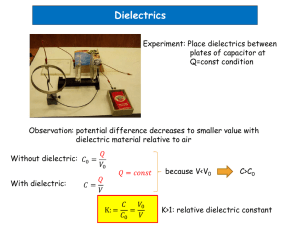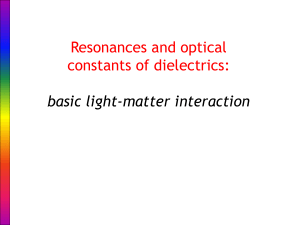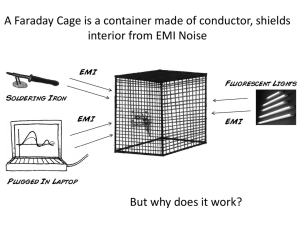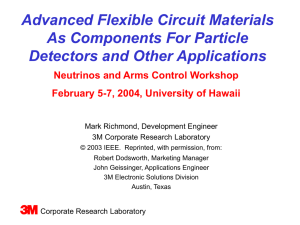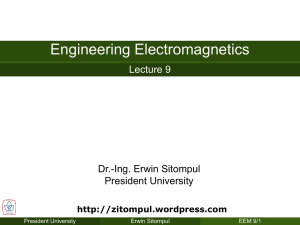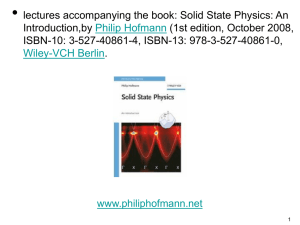Lecture Section 10
advertisement
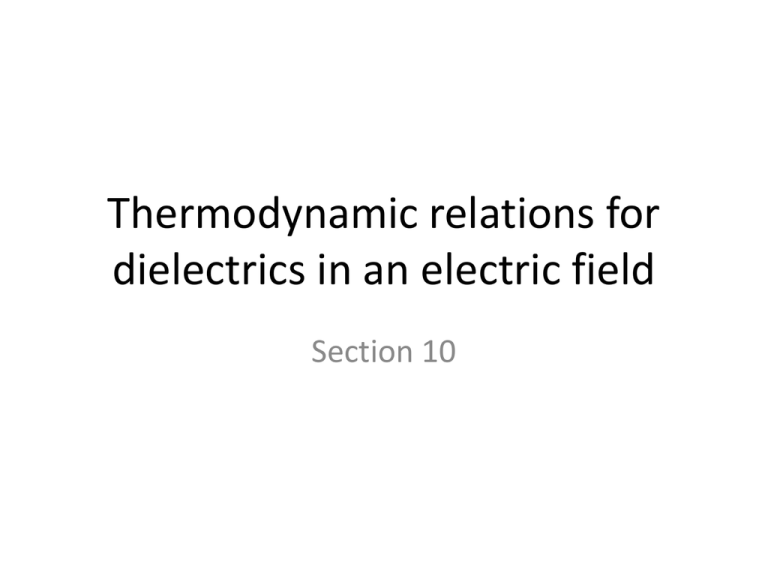
Thermodynamic relations for dielectrics in an electric field Section 10 Basic thermodynamics • We always need at least 3 thermodynamic variables – One extrinsic, e.g. volume – One intrinsic, e.g. pressure – Temperature • Because of the equation of state, only 2 of these are independent Thermodynamic Potentials In vacuum, they are all the same, since P = S = 0, so we just used U Internal energy and Enthalpy • U is used to express the 1st law (energy conservation) dU = TdS – PdV = dQ + dR = Heat flowing in + work done on Heat function or Enthalpy H is used in situations of constant pressure e.g. chemistry in a test tube Helmholtz Free Energy • F is used in situations of constant temperature, e.g. sample in helium bath Gibbs Free Energy or Thermodynamic Potential • G is used to describe phase transitions – Constant T and P – G never increases – Equality holds for reversible processes – G is a minimum in equilibrium for constant T & P Irreversible processes at constant V and T • dF is negative or zero. – F can only decrease – In equilibrium, F = minimum • F is useful for study of condensed matter – Experimentally, it is very easy to control T, but it is hard to control S • For gas F = F(V,T), and F seeks a minimum at constant V & T, so gas sample needs to be confined in a bottle. • For solid, V never changes much (electrostriction). What thermodynamic variables to use for dielectric in an electric field? • P cannot be defined because electric forces are generally not uniform or isotropic in the body. • V is also not a good variable: it doesn’t describe the thermodynamic state of an inhomogeneous body as a whole. • F = F[intrinsic variable (TBD), extrinsic variable (TBD), T] Why for conductors did we use only U? • E = 0 inside the conductor. • The electric field does not change the thermodynamic state of a conductor, since it doesn’t penetrate. • Conductor’s thermodynamic state is irrelevant. • Situation is the same as for vacuum U = F = H = G. Electric field penetrates a dielectric and changes its thermodynamic state • What is the work done on a thermally insulated dielectric when the field in it changes? • Field is due to charged conductors somewhere outside. • A change in the field is due to a change in the charge on those conductors. Dielectric in an external field caused by some charged conductors Simpler, but equivalent: A charged conductor surrounded by dielectric Might be non-uniform and include regions of vacuum Conductor Take Dn to be the component of D out of the dielectric and into the conductor. Surface charge on conductor is extraneous charge on the dielectric Electric induction exists in the dielectric Work done to increase charge by de is dR = f de Gauss Volume outside conductor =volume of dielectric, including any vacuum The varied field must satisfy the field equations Work done on dielectric due to an increase of the charge on the conductor Volume outside conductor =volume of dielectric, including any vacuum First Law of Thermodynamics (conservation of energy) • Change in internal energy = heat flowing in + work done on • dU = dQ + dR = TdS + dR • For thermally insulated body, dQ = TdS = 0 – Constant entropy dR = dU|S 1st law for dielectrics in an E-field No PdV term, since V is not a good variable when body becomes inhomogeneous in an E-field. For uniform T, T is a good variable, and Helmholtz free energy is useful Legendre transform Are all extrinsic quantities proportional to the volume of material Define new intrinsic quantities per unit volume Integral over volume removed New one First law Basis of thermodynamics of dielectrics Energy per unit volume is a function of mass density, too. Chemical potential referred to unit mass For gas we had mdN, where m = chemical potential referred to one particle Free energy Electric field F is the more convenient potential: It is easier to hold T constant than S Define new potentials by Legendre Transformation E T, r For conductor embedded in a dielectric For several conductors Potential on ath conductor Charge on ath conductor Extrinsic internal energy with E as a the independent variable This is the same relation as (5.5) for conductors in vacuum, where mechanical energy in terms of ea was and in terms of fa was Variation of free energy at constant T = work done on the body Extra charge brought to the ath conductor from infinity Potential of ath conductor (potential energy per unit charge) Variation of free energy, with E as variable, at constant T Similarly for And For T and ea constant, a body will undergo irreversible processes until is minimized. Then equilibrium is established. For T and fa constant, a body will undergo irreversible processes until is minimized. Then equilibrium is established. For S and ea constant, a body will undergo irreversible processes until is minimized. Then equilibrium is established. For S and fa constant, a body will undergo irreversible processes until is minimized. Then equilibrium is established. Linear isotropic dielectrics integrate = internal energy per unit volume of dielectric Free energy per unit volume of dielectric The term is the change in U for constant S and r due to the field and it is the change in F for constant T and r due to the field. For and , E is the independent variable, so Difference is in sign, just as in section 5 for vacuum field energy. Result good only for linear dielectric Total free energy = integral over space of free energy per unit volume If dielectric fills all space outside conductors For given changes on conductors ea Dielectric reduces the fa by factor 1/e Field energy also reduce by factor 1/e For given potentials on conductors fa maintained by battery Charges on conductors increased by factor e Field energy also increased by factor e
